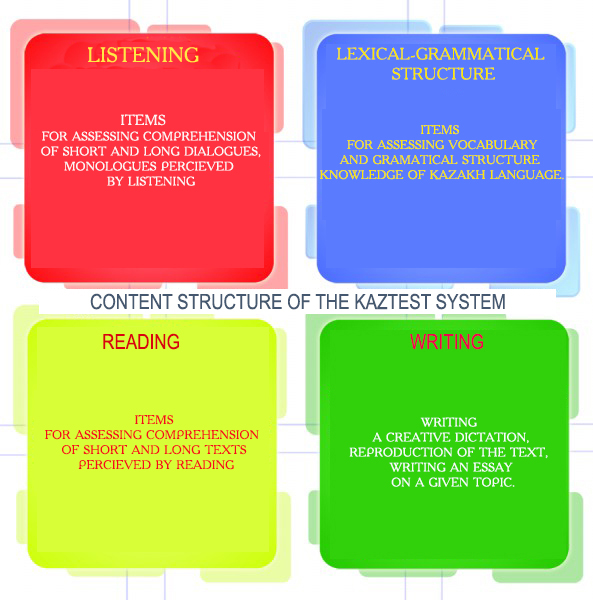KAZTEST structure consists of four blocks: Listening, Lexical-grammatical structure, Reading and Writing.

1-block Listening 30 test items
Texts are divided into short, small, medium and long texts according to their volume.
Texts for levels A1, A2:
· dialogues based on everyday life;
· cultural and social dialogues;
· descriptive texts;
· texts from mass media.
Texts for levels B1, B2, C1:
· mass media materials;
· dialogues from cultural and social spheres;
· dialogues based on welfare;
· dialogues on official sphere;
· samples from official documents;
· dialogues from popular-scientific sphere;
Test items assess the following skills:
· vocabulary usage (dialogue completion);
· comprehension of main idea (define the dialogue content);
· sorting out the information (find the information according to/contradicting the dialogue);
· finding necessary information (when, why, who, where, how);
· concluding (making conclusion);
· cause and effect (finding a reason that caused the effect);
· finding the point of view.
2-block Lexical-grammatical structure 70 test items
This block assesses the level of mastering lexical and grammatical materials, their use in communication, application in writing from functional and communicative point of view. Test items in this area aim to assess the level of linguistic competence, the concept of language structure that is necessary to solve certain communicative problems.
Test items include tasks from Kazakh language phonetics, morphology, lexis and grammar:
• address (a word spoken to draw somebody’s attention to oneself);
• future tense (show the action that will be performed);
• elapsed time (show the action that was performed);
• homonym (show similar sounding, but different words in meaning);
• synonym (identify words that are close in their meaning);
• antonym (find words that are opposite in their meaning);
• fused words (show words that are formed by combining two words).
Types of test items are complicated depending on their levels. For example, Numerals, test items in A1 level ask numbers from 1 to 100, and simple types of numbers: one, two, three (quantitative numbers), first, second, third (ordinal numbers).
In A2 level asks knowledge of numbers from 100 and above, collective numerals, fractional numerals and in higher levels asks complex types of numerals and their function in the sentence.
The test items should be interesting, modern, reliable and real to everyday life. This, in turn, has an impact on improving the functionality of the Kazakh language.
3-block Reading 50 test items
The purpose of Reading block is the perception and understanding of the basic and additional information of the text at different levels, the ability to read and analyze the text.
Texts are taken from textbooks, newspapers, magazines and fiction.
Text content recommended for A1, A2 levels:
• text messages (SMS, letters, announcements, advertising, etc.);
• cultural and everyday texts;
• small descriptive texts;
• interesting texts of various genres.
Text content recommended for B1, B2, C1 levels:
• description, narration with elements of reasoning;
• research texts;
• informational and descriptive texts;
• fragments from fiction, novels and short stories.
• informational and regulatory description of texts.
Test items assess the following skills of test-takers:
• to identify personal opinion and judgment of the author;
• to group the information according to certain descriptions;
• to find logical relation between events and facts;
• to determine necessary information;
• to identify the main idea;
• to give explanation to complex sentences;
• distinguish subjective information from objective;
• find the necessary facts (examples, reasons and arguments).
3-block Writing (2-4 tasks)
A1 level:
• Text type - adapted story or text;
• Text volume (number of words) - 60-80 words (dictation);
• Text content - socio-cultural and social spheres;
A2 level:
• Text type - narration, message, adapted texts and mixed dialogues;
• Text volume (number of words) - 80-100 words (dictation);
• Text content - everyday communication, socio-cultural and educational spheres;
B1 level:
• Text type - narration, description, message and mixed types of texts with elements of reasoning (diagram, graph, etc.);
• Text volume (number of words) - 150-250 words (reproduction);
• Text content - socio-cultural sphere;
B2 level:
• Type of text - narration, description using emotionally expressive means;
• Text volume (number of words) - 250-300 words (reproduction);
• Text content - social, cultural, business and official spheres;
C1 level:
• Text type - unadapted situational-thematic texts and dialogues;
• Text volume (number of words) - 300-350 words (essay);
• Text content - socio-cultural, scientific, official, business and educational areas relevant to everyday communication;
Tasks on the "Writing" block are designed to determine the following skills of the test test-taker:
• correct spelling of sentences, in accordance with spelling and punctuation (dictation);
• make a simple sentence (answering the questions);
• use synonymous words;
• comprehension, differentiation and evaluation of the information (draw up a dialogue);
• to raise a question and be able to express thought and opinion in it (draw up a dialogue);
• make a plan of the text (make a plan of presentation);
• convey the basic information of the heard text and the meaning of the text in a logical form;
• using arguments, write your thoughts, point of view, opinion on the text (write a statement);
• be able to logically convey a thought, revealing the content in your own words, using keywords in a systematic manner, convey the essence of events (essay);
• summarize the thought, formulate and make conclusion.
проспект Победы, 60
test@kazakhtest.kz